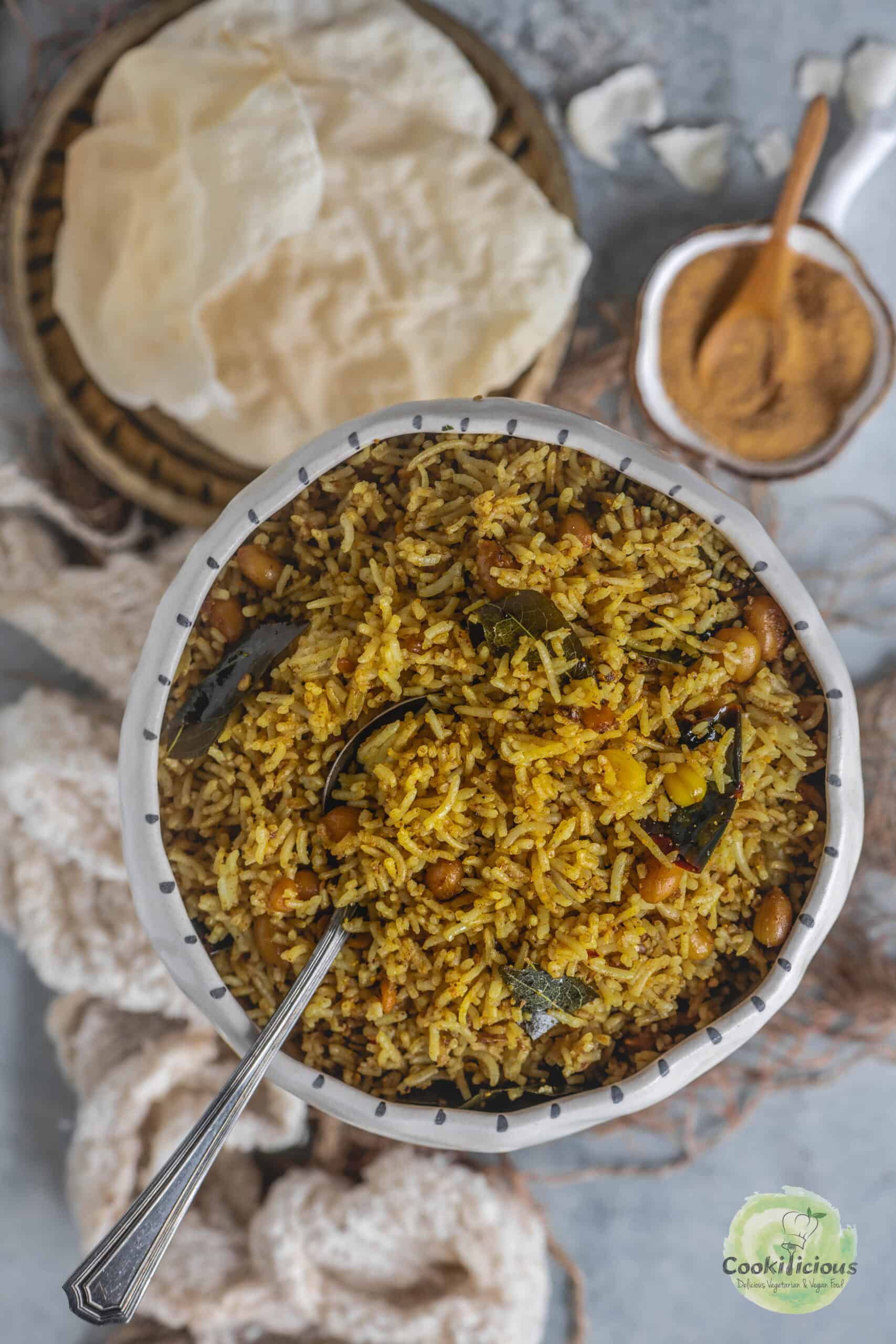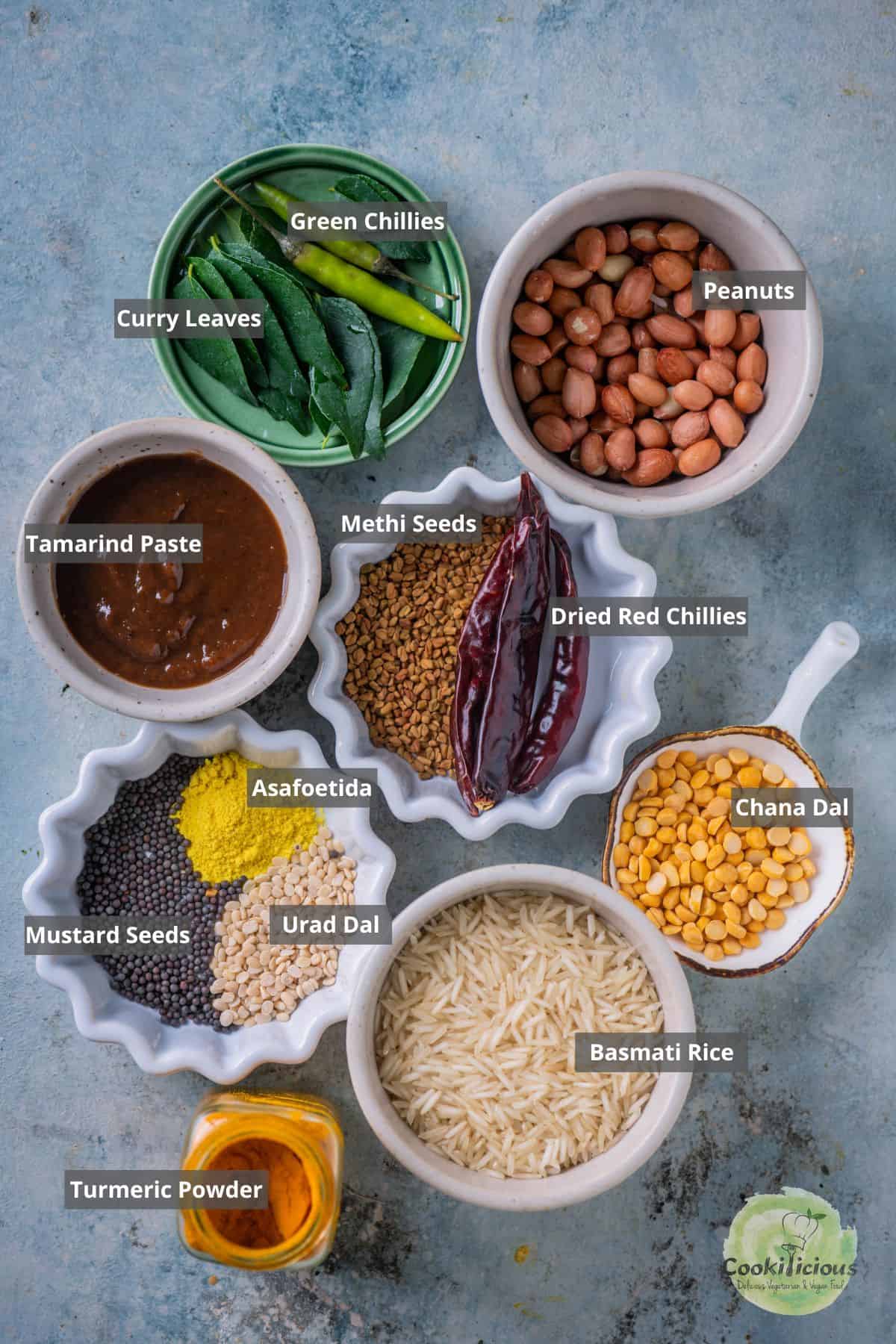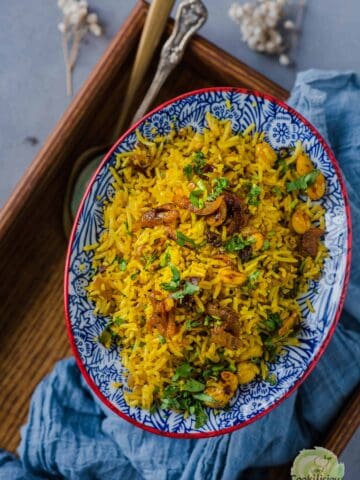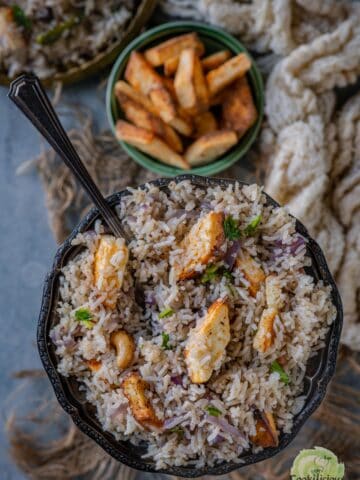Master the authentic South Indian Puliyogare-a tangy Tamarind Rice dish packed with bold flavors! This easy, vegan, and gluten-free recipe includes a step-by-step guide to making Puliogare paste from scratch, blending tamarind, peanuts, and spices to perfection. Ready in 40 minutes, this comforting Puli Sadam is perfect for lunch, dinner, or festive occasions.

Jump to:
What Is Puliyogare
Puliyogare, or Tamarind Rice, is a classic South Indian dish renowned for its tangy, aromatic, and bold flavors. The name originates from the Tamil words Puli (meaning "sour" or "tamarind") and Ogare (meaning "seasoned rice"). It is a versatile dish with regional variations such as Pulihora in Andhra Pradesh, Puliyogare Gojju in Karnataka, Puliyodharai in Tamil Nadu, Imli Rice in Hindi, Melkote Iyengar Puliogare, and Temple-style Puli Sadam. Despite these differences, the core idea remains the same-perfectly cooked rice infused with a tangy tamarind base and a medley of spices.
Tamil-style Puliyogare is prepared by mixing cooked rice with a tangy, spiced tamarind paste known as Pulikachal or tamarind powder. Pulikachal is typically a pre-made concentrate crafted by simmering tamarind pulp with a mix of aromatic spices, seasonings, and sometimes jaggery, which balances the sourness with a hint of sweetness. Adding roasted nuts, and lentils like chana dal, or cashews enhances Pulihora with a delightful crunch and texture. Since the tamarind paste or Pulihora powder can be stored for months, this flavorful dish is quick and convenient to prepare.
Why Is Pulihora So Popular
This dish is loved for its bold, tangy flavors and ease of preparation. The ability to pre-make and store tamarind paste makes it an excellent option for quick meals, festive occasions, or packed lunches. Its rich flavor profile, combining tanginess, spiciness, and nuttiness, makes it a comforting and satisfying meal for all age groups. Puliyogare Gojju also holds cultural significance, often served as prasadam (blessed food) in South Indian temples during religious ceremonies.
Cultural and Practical Significance of Puliyodharai
Puliyodharai, or Tamarind Rice, is a cherished South Indian dish deeply rooted in tradition. Often prepared during festivals and offered as prasadam in temples, it symbolizes devotion and heritage. Alongside dishes like Curd Rice, Lemon Rice, and Sweet Pongal, it holds a prominent place in South Indian households and festive celebrations.
Puliyodharai's tangy, spiced flavors and natural preservative qualities make it ideal for travel, picnics, and packed lunches, staying fresh for long periods. Its versatility allows for customization, while regional variations, like Iyengar-style Puliyodharai or Andhra's Pulihora, add unique twists to this classic dish. Kovil Puliyodharai seamlessly blends tradition, practicality, and bold flavors, ensuring its timeless appeal.
My Family Recipe
This Puliyogare Rice recipe is a cherished family heirloom, lovingly passed down from my mother-in-law. Her version embodies the authentic Tamil Brahmin or temple-style Puliyodharai, crafted with aromatic ingredients, resulting in a distinct and traditional flavor.
Every household has its unique take on Tamarind Rice, and this Pulihora Rice recipe holds a special place in ours. It's simple to prepare yet bursting with bold, tangy flavors, making it one of the easiest and most satisfying rice dishes you'll ever try. While the MTR Puliyogare Mix that you get in the stores, is quite good, making it at home is even easier and tastes so much better!
Some beloved varieties of South Indian Kalanda Sadam (flavored rice) include Thengai Sadam, Lemon Rice, Tomato Rice, Capsicum Pulao, Sesame Rice, and Curd Rice. Each of these traditional rice dishes brings unique flavors and textures, making them staples in South Indian cuisine and perfect accompaniments to any meal.
Why Make This
- Naturally Vegan, Gluten-Free and Jain-Friendly
- Instant Pulikachal recipe
- Perfect for Leftovers: A delicious way to transform leftover rice into a flavorful meal
- Authentically South Indian: Enjoy instant traditional flavors in every bite with this time-honored temple Pulihora recipe
- Healthier Alternative: Features a homemade Puliyogare paste with less oil and no preservatives, offering a wholesome option compared to store-bought mixes
- Diet-Friendly: Made without onion, garlic, ginger, or coconut, it's ideal for religious occasions or specific dietary needs.
Ingredients Needed 🧾

Rice: I prefer Basmati rice for its light and fluffy texture, but any short-grain variety works well. Avoid Jasmine rice, as it tends to become mushy.
Tamarind: Tamarind paste is used to prepare the Pulikachal. Opt for good-quality tamarind or use fresh tamarind or pulp for authentic flavor. Tamarind is also a key ingredient in dishes like Sambhar, Rasam, Sindhi Kadhi, and Beetroot Rasam Rice!
Seeds, Lentils, and Nuts: Mustard seeds, fenugreek (methi) seeds, urad dal, chana dal, and peanuts add depth of flavor and a delightful crunch.
Aromatics: Turmeric powder, gluten-free asafoetida, dried red chilies, fresh curry leaves, and green chilies lend an authentic and aromatic touch to this South Indian Tamarind Rice recipe.
Oil: Traditionally, Puli Sadam is prepared with Indian sesame oil, but you can substitute any vegetable oil if it is unavailable.
How To Make It 🔪

Want to save this recipe?
To Prep For Puliyogare
- Cook the Rice: Prepare it in advance using your preferred method. For the best texture, ensure the grains are separate and not mushy. Cooking it ahead and allowing it to cool completely helps achieve this.
- Prep: Dilute tamarind paste with water to create a smooth mixture. Simultaneously, soak chana dal in water to soften it.
- Roast and Grind Spices: Dry roast methi seeds and dried red chilies on medium heat for about 2 minutes until the seeds change color slightly.
- Allow the roasted spices to cool completely before grinding into a fine powder. Do not add any water. You can also crush them using a mortar and pestle.

- Heat Oil and Temper Spices: Heat sesame oil in a pan. Once hot, temper mustard seeds until they crackle. Add a pinch of asafoetida and urad dal, sautéing until golden.
- Add Aromatics: Toss in curry leaves, green chilies, and dried red chilies. Chef Tip: For extra flavor, add a teaspoon of ginger paste at this point.
- Cook the Dal and Peanuts: Add the soaked and drained chana dal, peanuts, and turmeric powder. Stir and sauté for about a minute to combine the flavors.
- Add Tamarind Water: Pour in the tamarind water mixture and stir. Let it cook on medium flame for 8-10 minutes, or until the mixture thickens.

- Add Salt and Methi Powder: Once the mixture thickens and no longer sticks to the pan, add a pinch of salt and the ground methi powder. Drizzle in a teaspoon of sesame oil and mix thoroughly. Also, add brown sugar or jaggery powder at this point if you want.
- Prepare Pulikachal: The mixture should come together smoothly, forming a paste that no longer sticks to the pan. This is Pulikachal or Pulihora instant mix (Puliodarai paste), which if you make it in bulk can be stored in an airtight container for up to a month in the fridge for later use. Otherwise, you can proceed to make the Tamarind Rice right away.
- Combine with Rice: Add the cooked rice, a pinch of salt, and a teaspoon of sesame oil to the paste. Mix well and taste, adding more salt if needed.
- Final Touches: Sprinkle a tablespoon of ground methi powder on top, then drizzle another teaspoon of sesame oil on top. Mix everything and remove from heat.

Serving Suggestions 🍽
Puliyogare Rice is a versatile dish that can be paired with various accompaniments to enhance its flavors. It tastes wonderful with fried or roasted papad, crunchy Banana Chips, or a side of flavorful Potato Fry for added texture. To balance its tangy and spicy profile, serve it with a bowl of yogurt, cooling Chaas, or even Curd Rice. For a complete meal experience, pair Tamarind Rice with creamy Paal Payasam as a dessert.
This dish is suitable for any time of the day, whether breakfast, lunch, dinner or even as a savory snack. Its ability to stay fresh for up to 12 hours makes it ideal for lunchboxes, picnics, and road trips. Puliogare Gojju is also a favorite at potlucks, weekend brunches, and festive occasions like Janmashtami, Navratri, Ganesh Chaturthi, Diwali, or Nombu. Its portability and crowd-pleasing flavors make it a delightful addition to both casual meals and celebratory feasts.
Priya's Recipe Tips 💭
Since the Puliyogare paste is made from scratch, feel free to adjust the spice level to suit your taste. After preparing the Pulihora, taste it to ensure the flavors are balanced. If the tamarind isn't tangy enough, you can enhance the flavor of this Kovil Puliyodharai with a squeeze of fresh lemon juice for extra sourness. You can also add sesame seeds in tempering. Grated carrots can also be mixed into the rice.
For those with a peanut allergy, simply omit the peanuts-they won't compromise the flavor. If you find the fried chana dal too hard to chew, soaking it in water for 10 minutes before cooking can soften it, making it easier to enjoy in the dish.
FAQs 📖
For the perfect homemade but Kovil-style Puliyogare, choosing the right rice is essential. I prefer using Basmati rice for its long, fluffy grains that hold up beautifully when mixed with the tamarind paste. Alternatively, short-grain variety works well too. However, it's best to avoid Jasmine rice, as it can become too mushy and sticky, altering the dish's texture.
If you have leftover rice, it's ideal for instant Puliyogare, especially if it's not being made as Naividhyam or Prasadam. When cooking rice from scratch, prepare it in advance and let it cool completely. This helps keep the grains separate and ensures the tamarind paste blends evenly without making the rice soggy.
There are plenty of options to suit different dietary preferences. Brown rice makes a fantastic substitute, adding a nuttier flavor and a chewy texture while boosting fiber content. Quinoa is another excellent choice, providing a protein-rich, fluffy alternative that pairs beautifully with the tamarind paste.
For a gluten-free option, consider using oats-they absorb the tangy flavors well and are easy to prepare.
Thin rice noodles work wonderfully for a variation like Puli Sevai, offering a similar flavor and texture. Poha (flattened rice) or puffed rice, commonly used in dishes like Puli Aval, can also be used as a lighter, crunchier alternative. If you're aiming for a low-carb version, riced cauliflower is an ideal option, delivering all the bold, tangy flavors without the carbs. These substitutions allow you to enjoy Puliyodarai while catering to your dietary needs and preferences!
Puliyodarai Mix (Pulikachal) can be prepared ahead of time and stored in an airtight container in the fridge for up to a month. For longer storage, you can freeze the mix, ensuring you always have it ready for a quick meal. Leftover Puliyodarai Sadam can also be refrigerated for up to a week. To freeze, let it cool completely before transferring it to an airtight container or freezer bag. Properly stored, it will stay fresh in the freezer for 1-2 months.
When reheating, thaw frozen rice in the fridge overnight or heat it directly from frozen using a microwave or stove. If the rice seems dry after reheating, add a splash of water or a drizzle of sesame oil to refresh its texture and flavor. This makes Puliyodarai perfect for meal prep, allowing you to enjoy its tangy, aromatic taste with minimal effort anytime!
If you're short on time or ingredients, store-bought tamarind paste or MTR Tamarind powder works well as a substitute for homemade tamarind paste. To maintain the authentic flavor, follow the tempering steps mentioned in the Puliyogare Sadam recipe and include the methi seed spice blend, simply skipping the addition of homemade tamarind paste. Use the store-bought MTR paste instead.
For variations, Pulihora can also be made using other souring agents like raw mango (kairi), kokum, gongura, tomato, or lemon. Each option brings its unique tanginess while still delivering a delicious twist to the classic dish. These alternatives are especially handy when tamarind isn't available!
Add all the ingredients in saute mode. Lastly, add the rinsed rice and water to the pot. For one cup of rice add two cups of water. Cook in manual mode for 4 minutes. Release the pressure manually 5 minutes after the pot beeps. Fluff the Puli Sadam with a fork.
To make the Puliyogare recipe with powder, heat a teaspoon of sesame oil in a pan. Once the oil is hot, add a tablespoon of chana dal, 6-7 dried red chilies, ¼ teaspoon of asafoetida, ¼ teaspoon of fenugreek seeds, 1 tablespoon of coriander seeds, ½ teaspoon of black peppercorns, and 10-12 fresh curry leaves. Roast the ingredients thoroughly until the chana dal turns golden and aromatic. Then, add a dry lemon-sized ball of tamarind to the mix (note: tamarind paste, pulp, or purée cannot be used for this powder).
Transfer the roasted mixture to a plate to cool completely. Once cooled, grind it into a fine powder without adding any water. Add salt to taste, and store the Pulikachal Powder in an airtight container. You can use this instead of the Pulikachal we have made in this recipe.
More Recipes To Make With Leftover Rice

⭐️ Subscribe to the Cookilicious Newsletter and receive new recipes straight to your inbox! You'll receive my FREE Vegan Beginner's guide as a gift. Ready to elevate your cooking game? Purchase my Cookbook - The Essential Vegan Indian Cookbook today!
Recipe 📖

Puliyogare Recipe | South Indian Tamarind Rice
Equipment
- 1 pan
Ingredients
- 2 cups Basmati rice
- 1 tablespoon methi seeds
- 2 dried red chillies
- ⅓ cup sesame oil
- 6 tablespoon tamarind paste
- 1 cup water
To Make Pulikachal
- ¼ cup sesame oil
- 1 teaspoon mustard seeds
- 1 teaspoon urad dal
- 1 tablespoon chana dal
- 1 teaspoon asafoetida
- 1 teaspoon turmeric powder
- 1 teaspoon jaggery powder optional
- 8-10 curry leaves
- 2 green chillies
- 1 dried red chilly
- Tamarind water
Instructions
- Cook rice ahead of time. Use whatever method works for you. Just ensure the rice is not mushy and the grains are seperate. It helps to cook it way ahead of time and then cool it.
- Mix tamarind paste with water. Soak chana dal in water.
- Dry roast methi seeds and dried red chillies for 2 minutes on medium flame. The color of the seeds with change a bit.
- Let the seeds cool and then grind it to fine powder.
To Make Pulikachal
- Heat sesame oil in a pan. Temper mustard seeds. Add asafoetida and urad dal.
- Once the mustard seeds crackle, add curry leaves, green chillies, and dried red chilly.
- Add soaked chana dal, peanuts, and turmeric powder. Mix and saute for a minute.
- Now add the tamarind water. Mix till it thickens. This could take 8-10 minutes on medium flame.
- Once it thickens, add little salt and the ground methi powder. Drizzle a teaspoon of sesame oil. Mix. Also add brown sugar or jaggery powder at this point if you want.
- The pulikachal should come together and not stick to the pan anymore.
- Then add the cooked rice, salt and a teaspoon of sesame oil. Mix and taste. Add more salt if needed.
- Sprinkle a tablespoon of the ground methi powder in the end. Drizzle a teaspoon of sesame oil on top. Mix and take it off the flame.












Pravin says
Delicious
Priya says
Thank you.